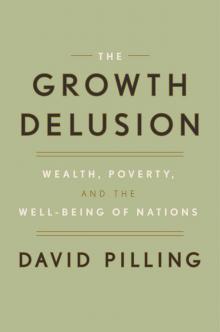- Home
- David Pilling
The Growth Delusion Page 8
The Growth Delusion Read online
Page 8
As technology races ahead and as the price of some products tends to zero, some economists argue that the consumer surplus is widening. One way of testing the theory is to see how much early adopters are willing to pay for, say, the latest iPhone. The gap between the opening-weekend price and the price at which the phone eventually settles is the consumer surplus, at least for them. Or you could threaten to take away someone’s iPhone and see how much they would pay you to get it back. An iPhone is not just a piece of equipment, but also a means of connecting to networks of friends and business associates and of accessing information. “I think the real value is many thousands of dollars per person,” says Gavyn Davies. “That’s a humongous mismeasurement of the value that the iPhone has brought to most human beings.”
Most experts agree that, because of these technological upheavals, national accounts underestimate economic growth. But estimates differ widely—not to say wildly—as to how much. Erik Brynjolfsson of the Massachusetts Institute of Technology noted in 2012 that the information sector accounted for the same official share of GDP in the US—about 4 percent—as it had done a quarter of a century earlier. This is implausible, to put it politely. Many people have taken a stab at calculating what we are missing in the official figures. Methods vary.6 They include attaching an hourly wage to the time we spend on the Internet, estimated at $22 in one Google study, since that was the average US wage at the time.7
Brynjolfsson and a colleague, JooHee Oh, conducted their own exercise. They started with a finding that, between 2002 and 2011, the amount of leisure time Americans spent surfing the net, using services such as Facebook, Google, Wikipedia, and YouTube, rose from 3 to 5.8 hours a week. Since consumers could have used the time for something else, the authors assumed that the extra hours spent on the Internet reflected a growing consumer surplus that they calculated at $2,600 per user for a grand US-wide total of $564 billion in 2011. If included in national statistics, that would have raised growth by 0.4 percentage points a year. Other estimates have come up with nearly twice that.8
Not everyone agrees that staring at Facebook should be counted as economic activity, particularly if people do it at work when they could be doing something useful—like chatting to colleagues. Why should watching YouTube be counted when watching TV or playing with your children or walking in the park is not? Should we really put more of a value on watching a cat video than, say—to pick an entirely random activity out of thin air—watching a real cat? The benefits of the Internet can be overstated as well as understated.
* * *
—
There is, it says in Ecclesiastes 1:9, no new thing under the sun. Doubtless the dude who wrote that copied it from somewhere else. We have always had a hard time accounting for innovation. That applies equally to improvements in cars and photocopy machines as it does to faster Internet speeds. When new inventions first appear they can be incredibly expensive. One example is medicines, which are protected by patents. These allow pharmaceutical companies to charge hundreds, if not thousands, of dollars for their products. But when the patent runs out, the price of the same medicine falls to pennies and the product essentially vanishes from the economy.
If you think technology is accelerating faster than ever before, as many do, then the mismeasurement problem is getting worse. But there are serious academics who contend that the really important advances in technology are all behind us. Robert Gordon, an expert on productivity at Northwestern University, argues that all the truly transformative inventions came about after 1870 and more or less ran out of steam around 1970. He cites the invention of electricity and the internal combustion engine, and the provision of clean water and sewage disposal. These led to the invention of machines such as the telephone, the radio, the refrigerator, the car, and aircraft. Many of these technologies in turn produced huge ripple effects.
Ha-Joon Chang, a Cambridge economist, says the washing machine was a far more revolutionary invention (pun intended) than the Internet. Why? “The washing machine, piped gas, running water and all these mundane household technologies enabled women to enter the labor market, which then meant that they had fewer children, had them later, invested more in each of them, especially female children. That changed their bargaining positions within the household and in wider society, giving women votes and prompting endless other changes. It has transformed the way we live.”9 Gordon argues that technology has had a profound impact on society, but that this impact is diminishing. The speed of travel went from the horse and carriage to the jet plane, but plane speeds got stuck some fifty years ago. Urbanization and the transformation of women’s lives by domestic appliances are one-off events. Once they have occurred, these technological leaps quickly fade in the statistics.
Still, it seems a fair bet that the computer revolution will transform our lives in ways we hardly yet comprehend. Robots and artificial intelligence will render many of the jobs we do today redundant, changes that are only hinted at with the automated answering services and supermarket auto-checkout machines that have already become part of everyday life. Cars will drive themselves, packages will come by drone, and robots will prescribe medicines and take care of the elderly. In Japan robots have been building other robots for many years.
If new inventions are all about the exchange of information and “standing on the shoulders of giants,” then technological advances can only accelerate as more and more people get access to information. Increasingly, even in developing countries, people have instant access to virtually the entire body of human knowledge, something that would have been inconceivable even in 1990. In Rwanda there are plans to give 12 million people access to an AI doctor, which would give medical advice based on a description of symptoms over the phone.10
This debate about whether we are underestimating growth lies at the heart of what is perhaps the greatest conundrum faced by the economic profession. Amid all this innovation and technological change, why has productivity stagnated? The answer could be that improvements are simply not being picked up. Of course, it could also be that technology is somehow not bringing the expected jump in productivity that people expected, but this seems less likely.
The conundrum is central to how people feel about their circumstances. Many in Europe and America, particularly in the so-called shrinking middle class, are upset at the perceived stagnation of their living standards. But if growth is being underestimated, it could be that many are better off than they think. If we could only capture technological change better, maybe we would realize that our lives are not so bad after all. Alternatively, perhaps people are unhappy about other things, including the loss of meaningful work, rising inequality, and the fracturing of communities. The fundamental point is that, on these and other matters, the concept of growth—as currently measured—sheds little light.
* * *
—
If you’ve never ridden on a Japanese bullet train it is hard to imagine the awesomeness of the experience. The sleek white trains with their comically elongated noses slide into the station with such precision that passengers standing at designated spots on the platform find themselves right in front of the door to their allotted carriage. The trains glide off in a matter of seconds to resume racing across the countryside at near-airplane speeds, and you are left to gape as the landscape streaks by or to purchase some freshly made delicacy from the bowing women pushing trolleys noiselessly through the carriages. Between Tokyo and Osaka there are about 300 daily services, which make the 552-kilometer journey in 2½ hours with an average delay measured in fractions of a second.
It is hard to put a price on quality. An economist would say that the price is whatever the customer agrees to pay since the market finds a natural equilibrium between supply and demand. That might just about work within a country, but when it comes to comparisons between countries, especially in the context of non-tradable services like a train between Tokyo and Osaka, the price test
breaks down. In the UK, no matter how much I may dread the prospect of long delays, shabby trains, and soggy bacon sandwiches on the London to Sunderland route, I cannot pay more to take a Japanese bullet train to the same destination.
The same is true of American Amtrak trains, which crawl along at speeds that belong in another century and have the odd fatal accident. (Not a single person has been killed by a bullet-train accident since Japan launched the service in 1964.) Imagine my surprise then when I came across a report from consultants McKinsey bemoaning the inefficiency of the Japanese service sector, up to and including its trains. Even the best Japanese companies, it said, reached only 85 percent the efficiency of the American system.11 That was pure economist-speak. For anyone who has actually taken a train in both countries, to say American or British trains are more efficient than Japanese ones is laughable. Economists have little to say on questions of quality. Criticisms of Japanese inefficiency stem from the fact that economists are not comparing like with like, since very few countries can match—and none exactly replicate—the service available in Japan.
Kyoji Fukao, a professor at Hitotsubashi University’s Economic Research Institute, helped provide much of the Japanese data that went into the international comparisons used by McKinsey and others. He agreed that the usual measures of service-sector efficiency—value added per man hour and total factor productivity, which incorporates capital and labor inputs—were crude and difficult to apply across borders. Fukao gave the example of Japan’s retail sector, lambasted for its inefficiency in the McKinsey report. The basic measure of retail-sector productivity is how much of a product an employee can shift in an hour. On this measure, Germany does well. That turns out to be because of restricted opening hours, which oblige customers to make hefty purchases in concentrated bursts. Japan does badly. That is partly because there are tiny shops on every street corner that sell the most dazzling array of products. Many are open twenty-four hours a day. They are cheap but of excellent quality and incredibly convenient, yet looked at in purely numerical terms less efficient than cavernous US superstores on the outskirts of big cities. These experiences are incomparable. Nor, incidentally, is any allowance made for the fact that Japanese shops tend to be within walking or, at most, cycling distance. Data fail to capture the inconvenience of having to drive out of town, or the “externalities”—the unmeasured side-effects—associated with long shopping expeditions: traffic accidents, pollution, road maintenance, stress, and lost time.
Services are inherently subjective. An engineer is asked how to make the service on the London–Paris Eurostar more pleasant. He recommends spending £6 billion on new track to shorten the three-and-a-half-hour journey by forty minutes. An advertising executive is asked the same question. He comes up with a different solution. He recommends hiring male and female supermodels to walk up and down the aisles dispensing free Chateau Petrus throughout the journey. The train company will save billions on new track. And passengers will actually ask for the trains to slow down.12
Even without cross-border complications, working out the output of services is much harder than for manufactured products. How do you compare something as simple as one haircut with another? There’s the boot-camp short-back-and-sides performed with an electric razor, or the three-hour session at a high-end salon in which every strand of hair is lovingly sculpted and the experience rounded off with a delicious head massage. But what about the decor of the salon and the skill of the hairdresser, not just in cutting hair but in artful conversation? And it’s not good enough to say that the price of the haircut tells you all you need to know about the quality, because the price will vary from year to year. How does the poor statistician work out price changes from one year to the next—essential if national income accounts are to make sense—if the service in question is hard to quantify and in constant flux?
If you think haircuts are hard, try the services that landscape gardeners or computer engineers provide, each individually tailored to the customer’s needs and virtually impossible to compare. National statistics agencies struggle with these questions daily. The US, for example, has more than 350 classification categories for manufactured goods, which account for less than a fifth of the economy, but fewer for the entire range of services, which make up some 80 percent of economic activity. The way we measure production was invented in the 1930s, but since then the nature of what we produce has changed beyond all recognition. Our standard measures of the economy struggle to tell us much at all about the vast bulk of things we actually consume. That is quite a flaw. It suggests we should take growth statistics less seriously than we do.13
* * *
—
In August 2016 the European Commission handed down its biggest ever tax judgment when it ordered Ireland to collect $14.5 billion (plus interest) in back taxes from Apple. The commission argued that Apple had engaged in a dubious profit-allocation scheme that allowed most of its profits to be moved to a “head office” on the outskirts of Cork, the southernmost county in Ireland. Effectively, the commission argued, Apple was tax-resident in no country in Europe, allowing it to shrink its European tax rate to well below 1 percent. For the record, Apple’s chief financial officer called the EU’s finding “legal mumbo jumbo” and said its calculation of Apple’s tax bill used the “wrong denominator and the wrong numerator”—though apart from that it was presumably spot on.
The dispute stems from claims of tax avoidance, but the arguments apply to how we measure the economy, particularly in an age when multinational companies are ever more sprawling and the stuff they are selling ever more intangible. In Apple’s case, much hinges on intellectual property. On paper Apple’s subsidiary in Ireland—a country that accounts for only a fraction of its sales—is super-profitable because that’s where Apple’s intellectual property rights are held. In the digital age the value of a product is not primarily found in a physical asset, but rather in the brand or intellectual or artistic content. Even for something as seemingly tangible as a jet engine, customers pay not only for the piece of equipment but also for sophisticated service contracts in which the provider monitors the engine in real time and keeps it running smoothly throughout its life.
Many multinational companies are able to move the source of value of their products—whether intellectual property, service contracts, or legal services—around their international networks almost willy-nilly. You may buy your engine in Seattle, but the people ensuring the engine keeps running for twenty years are in Mumbai. Through a practice known as transfer pricing one subsidiary charges another for the use of these intangible services and the profit is logged in one location—almost certainly the one with the lower tax rate. In 2014 Facebook caused an outcry in Britain by paying tax of just £4,327, a fact that helped provoke a tax revolt in one small Welsh town where tiny businesses were paying substantially more than that.14
GDP was conceived of in terms of the nation state, but businesses increasingly operate across borders. Gross national product, as it was originally called, measured everything produced by a country’s nationals, wherever they happened to work. Under the administration of George H. W. Bush that changed to the more familiar GDP, which measures anything produced within a nation’s borders, including by non-nationals. The reason for the switch may have been that Bush needed to boost his economic credentials. Switching to GDP, as opposed to GNP, increased the perceived US growth rate because it included the production of Japanese companies who had invested heavily in the American car and electronics industries.15
In these days of the multinational, when many Western companies have decamped to China, Mexico, or Vietnam, it makes more sense to use gross national product. Incidentally, that would make Western economies look better and the countries where the manufacturing takes place look worse than our current method of calculating the economy.16 What constitutes national production, however it is configured, becomes almost meaningless when companies are registered in
one country, make products in a second, sell them in a third, and pay taxes (if they really, really have to) in a fourth.
Apple’s European tax dispute is a good example. But so is the manufacture of Apple’s iPhones, most of which are assembled in factories in the southern Chinese city of Shenzhen owned incidentally by Hon Hai, a company from the breakaway island of Taiwan. The fact that Apple and many other American companies have chosen China as a manufacturing base is the reason the US runs such a big trade deficit with that country. Yet, the ostensible size of the trade deficit—despite being so politically explosive—is not that significant. That is because most of the components assembled in China are made elsewhere: microchips in South Korea, capacitors in Japan, and processors in the US itself. You don’t even need to open an iPhone to see what’s going on. Just flip it over and you’ll see “Designed by Apple in California. Assembled in China.” One report found that only 2 percent of the cost of an iPhone went to Chinese labor, with 30 percent going to Apple’s shareholders in the form of profits.
Even something as seemingly simple as an opal is hard to pin down. A book about Chungking Mansions, the dosshouse-cum-trading-hub in Hong Kong where people gather from all around the world to trade, recounts a dizzying example of low-end globalization.17 Australian opals are shipped, via Chungking Mansions, to southern China, where they are polished, sent back to Australia, and sold as souvenirs to Chinese tourists visiting Australia (who presumably take them back to China). In such a world the idea of domestic production—our very definition of the economy—becomes almost meaningless.

 The Growth Delusion
The Growth Delusion The Hooded Men
The Hooded Men Longsword
Longsword Medraut
Medraut Hardway
Hardway Holy Warrior
Holy Warrior Caesar's Sword: The Complete Campaigns
Caesar's Sword: The Complete Campaigns The Wolf Cub
The Wolf Cub Reiver
Reiver The Heretic
The Heretic Siege of Rome
Siege of Rome Loyalty
Loyalty The Path of Sorrow
The Path of Sorrow Caesar's Sword (I): The Red Death
Caesar's Sword (I): The Red Death Flame of the West
Flame of the West The Best Weapon
The Best Weapon Sacrifice
Sacrifice The Half-Hanged Man
The Half-Hanged Man